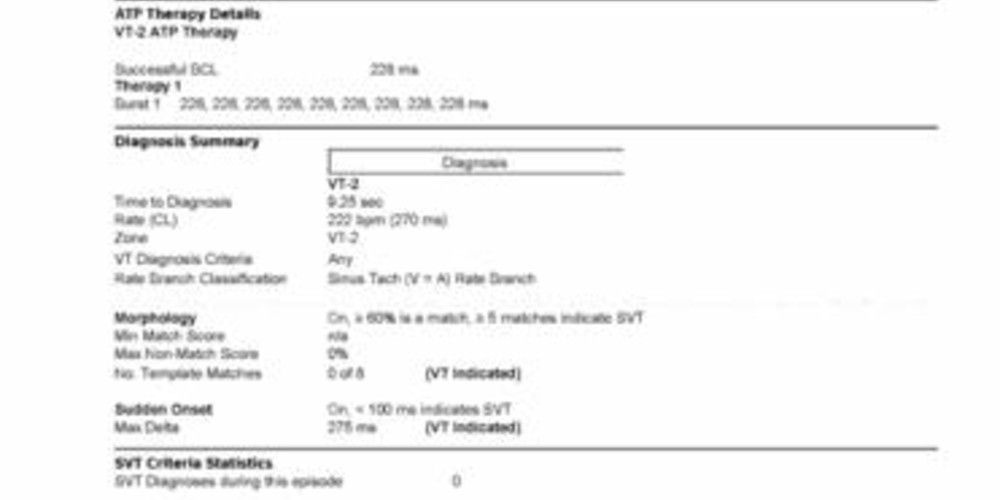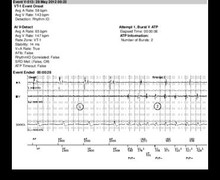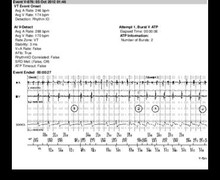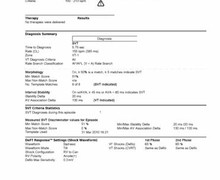Dual chamber discrimination: V=A
Tracing
Manufacturer Abbott
Device ICD
Field Discrimination
N° 47
Patient
A 38-year-old man presenting with hypertrophic cardiomyopathy underwent implantation of a Abbott Fortify dual chamber ICD after suffering an episode of aborted sudden death. He was seen in consultation, complaining of palpitations.
Main programmed parameters
- VF zone at 230 bpm, VT-2 zone at 176 bpm, and VT-1 zone at 148 bpm
- 20 cycles in the VF zone, 20 cycles in the VT-2 zone and 20 cycles in the VT-1 zone were needed for the diagnosis
- Effective discrimination in the VT-1 and VT-2 zone
- V<A: if one of the criteria is fulfilled; morphology (60%, 5 out of 8), stability (80 ms, with 60 ms delta AV association, 12 intervals)
- V=A: if one of the criteria is fulfilled; morphology (60%, 5 out of 8), sudden onset (100 ms)

Graph and trace
Narrative
Episode of VT diagnosed in the V=A arm; in this arm, 2 discrimination criteria, morphology and sudden onset are analyzed. In this patient 1 out of 2 criteria is needed for the diagnosis of VT; since both criteria point to VT, the device diagnoses VT and delivers a 10-cycle burst of ATP.
Tracing
- rapid sinus rhythm;
- the tachycardia begins with a ventricular extrasystole; the presence of retrograde conduction is noteworthy; after 3 F classified cycles, the episode-pacing mode is DDI;
- initially, the ventricular rate is above the atrial rate, unequivocally confirming the diagnosis of VT;
- regular 1:1 tachycardia with morphology unlike the reference QRS (x, 0);
- diagnosis of VT-2 (after 20 cycles classified T2) in the V=A arm (VT-2=); the onset of the tachycardia is sudden (analysis based on the first F cycle) and the morphology criterion for the 8 analyzed cycles is also in favor of VT (0, x);
- burst of 10 stimuli;
- successful burst and diagnosis of return to sinus rhythm (after 5 VS).
Other articles that may be of interest to you







If the ventricular and the atrial rates are the same (V=A arm), the defibrillator must distinguish VT with retrograde conduction, from sinus tachycardia or atrial tachycardia with 1:1 conduction, applying first a dual chamber criterion, i.e. AV interval delta (OFF in this patient) and then 2 single chamber criteria, i.e. sudden onset and morphology. These 2 criteria operate like those described in the single chamber discrimination. They might or might not be associated: “One of” or “All” criteria.
In this patient, the onset of the tachycardia is sudden, which rules out sinus tachycardia. The absence of morphology similarity compared with the reference favors VT rather than atrial tachycardia. Furthermore, the tachycardia starts with a ventricular extrasystole that also favors VT. The termination of the tachyarrhythmia by a salvo of ATP is not strictly in favor of VT, since the termination of a 1:1 atrial tachycardia by a ventricular burst not only is possible but relatively common.